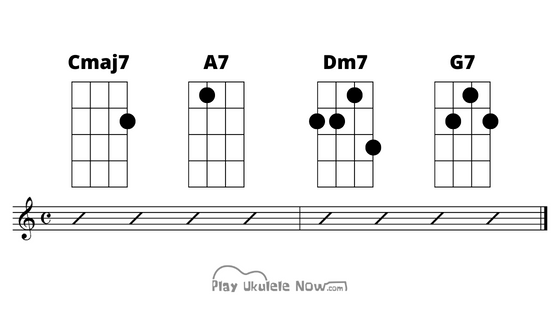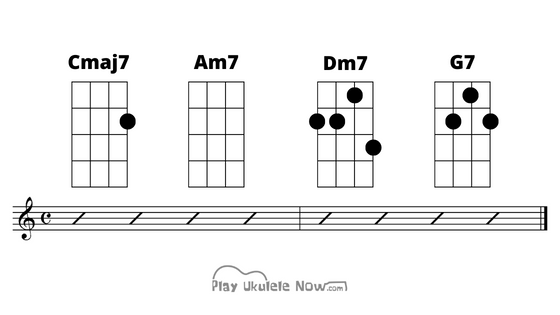Very popular substitute for a minor 7 chord.
You will Learn More and Play More with Play Ukulele NOW.
Find out for yourself why teachers and students have depended on Play Ukulele NOW Methods and Songbooks since 2009
Find out for yourself why teachers and students have depended on Play Ukulele NOW Methods and Songbooks since 2009
DISCLOSURE: THIS POST MAY CONTAIN AFFILIATE LINKS, MEANING I GET A COMMISSION IF YOU DECIDE TO MAKE A PURCHASE THROUGH MY LINKS, AT NO COST TO YOU. PLEASE READ MY DISCLOSURE FOR MORE INFO.
Find all my chord related posts here: Chord Tips and Tricks
We talked about substitutes (embellishments - quality changes) for the I chord previously now were going to cover substitutes for the ii chord. the chords we talk about here will work as substitutes for any minor chord.
Most popular choices for a ii substitute (embellishment)
Best choices for ii (iii, or vi) substitute (embellishment):
- Minor 7b5 (half diminished chord)
- Minor 9
- Minor 11
We kick this off with the minor 7b5.
Check out the minor 7b5
Play each and listen to the difference...
Try playing just the minor 7b5 alone, you will notice that is has a very dissonant sound when played alone but you will discover later (when we play it in progressions) that it takes on a different sound - they become beautifully balanced.
About the minor 7b5
The Minor 7b5 (minor seven flat five) is the only widely used altered minor chord (it is considered altered because of the b5). It is also one of the most commonly used substitutes (embellishment or quality change) for a minor 7 chord.
If you look at a scale harmonized with 7 chords you'll notice that the vii is a 7b5, in a harmonized scale this chord functions as a half diminished chord (a diminished chord has a b3, a b5 and a bb7 - a half diminished has a b3, a b5 and a b7). More on this later...
Lets take a look at it...
These are simply a minor 7 chord with a b5 so they're very easy to make - if you come across minor 7, just flatten the 5th (lower it by 1/2 step) and you'll have the minor 7b5.
Very popular replacement for a minor 7 chord in jazz - it is not to be used to start a song.
Rules to remember:
- If you take a minor 7th chord and flatten the 5th (lower it by 1/2 step) you'll have the minor 7b5.
- Not to be used to start a song
- Do not use if the b5 clashes with the melody note of the song (the note that the singer is singing).
GRAB YOUR (PDF) MINOR 7-5 CHORD CHARTS and a beautiful FULL COLOR CHEAT SHEET HERE (Charts show MAJOR 9 #11 chords all the way up the neck).
The minor 7b5 is actually two chords!
This idea will help you understand how I propose you use the chord as opposed to how some may think it should used.
The minor 7 b5 naturally occurs in a harmonized scale, in a major scale it's the vii chord and in a natural minor scale it's the ii chord. When the chord is used in those positions - where it naturally occurs - it is functioning as a half diminished chord and chord and SHOULD BE (but usually is not) called a half diminished chord.
when it is used as a substitute (or an embellishment for) a minor 7 chord in any other position it is NOT functioning as a half diminished chord - it would be functioning as an altered minor chord - so it would be correctly called a minor 7b5 - NOT an half diminished chord.
So it should be given a name based on it's function. As we're using it here is is not a half diminished chord we are using it exclusively as an altered minor chord.
Really - it's just a minor 7 chord with a b5...
How to use them
Wherever you see a minor 7 in a scale harmonized with 7 chords a minor 7b5 may be used.
The minor 7b5 may be substituted for the ii, iii, or vi chord (any minor 7chord).
For the progressions that follow try strumming each chord slowly (1 slow strum for each chord) and then go on to the next chord. Listen to the beauty of each chord - also play the with two strums per chord as indicated, repeat each progression a number of times.
Let's take a look at a ii V I progression...
Let's take a look at a ii V I progression...
PROGRESSION 1 - ii V I harmonized with 7 chords:
In this progression we can substitute the minor 7b5 for the ii chord (which is D minor 7); take a look:
PROGRESSION 2 - ii V I with the minor 7b5 for the ii chord:
Play progression 1 a number of times (repeating it etc...)
Then play progression 2 - listen closely to the difference... What do you think?
Notice that using the Dm7b5 creates a more intense resolution to the G7. This is why it's such a great choice for the ii.
Now lets take a look at a I VI ii V progression, we changed the quality of the VI like we did in the previous lessons.
PROGRESSION 3 - I VI ii V harmonized with 7 chords:
PROGRESSION 4 - I VI ii V with the minor 7b5 substituted for the ii chord:
We can use the minor 7b5 for the vi chord as well... typically the vi chord will be a minor chord (it was before the quality change we've been using).
Lets look at a I vi ii V now (with a minor chord for the vi; Am instead of the A7 we've been using).
PROGRESSION 5 - I vi ii V Harmonized with 7 chords:
PROGRESSION 6 - I vi ii V with the minor 7b5 substituted for vi & ii:
Whenever you run across a minor 7 you can slip these in. The only danger here is if the b5 clashes with the melody note (the note that the singer is singing) it won't work.
A step further...
For any of these progressions we can add the substitutions (embellishments) we learned previously as well. EXAMPLE: Lets take a look at the ii V I with the minor 7b5 for the ii chord and the Cmaj9 for the one chord.
PROGRESSION 7 - ii V I with minor 7b5 for the ii and C major 9 for the I:
The I chord could be any of the options we looked here try it with the others, a major 6, 6/9 or major 9 #11 for the I chord...
"Pin me" you 'Ukulele Friends' will want to see this"

.png)
.png)






.png)



.png)





No comments:
Post a Comment